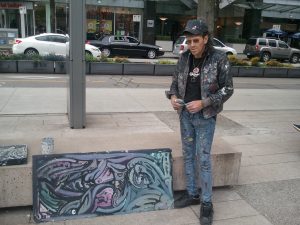I attended an International conference on outsider art in May. It was held at the University of Heidelberg, Germany, where the Prinzhorn collection is housed. The conference was initiated by the Prinzhorn collection and the European Outsider Art Association.
About 75 people attended the conference, most of them from European outsider art organizations like museums, studios and educational institutions. It was an incredible experience to be with a group of people who live and breathe outsider art; for once I didn’t have to explain what outsider art is and why I love it.
Over two days, papers were presented (and lively discussions followed) on ethical issues around outsider art. There were two main topics: dealing with outsider artists and the ownership of outsider art. We discussed the artists’ rights to equality; the viewpoints of artists, gallerists, psychiatrists and art promoters; and the ownership of outsider art. I’ll give you more details in upcoming blogs.
The most animated discussion was around ownership of outsider art: who has access to it, what permissions are needed, and so on. One organization, for example, is working with psychiatric hospitals in Germany to gain access to and archive their patients’ artwork. Some hospitals have agreed to join the project, while others have not.
There was some grumbling about institutions that will not release their patients’ artwork (when the patient cannot give his or her own consent). There was a feeling that it is in the “public interest” to document this artwork. While I agree that it would be interesting to see the work, I can understand the institution’s position. Looking at it from a legal perspective (which I can’t help doing), there is no “right of access” to anything in the doctor/patient file, particularly by a group of strangers! (An exception, of course, would be if there were an investigation into the practices of the institution and a need to access medical files and hospital records.) By denying access, the hospital is protecting their patients’ privacy – and so they should. If you were incapable of making the decision yourself, would you want your private artwork to be exposed to the public? I think not. A great deal of this artwork is produced from a place of trauma, and it is simply not appropriate to wretch that artwork from the hands of the creator and his or her care-giver. Period.
I expressed an unpopular view with respect to deceased artists. Some people were of the view that once an artist has died (and the next-of-kin are not available to consent), the artwork is available for public viewing. In my opinion, and aside from the legal ownership issues (to be discussed in a future blog), the curator must be extremely sensitive in deciding whether to exhibit the artwork. For example, if the artist has portrayed a traumatic event in graphic detail (such as sexual abuse), perhaps it is just “not right” to show that work to the world. Remember again: the work was created in a private setting, for personal reasons. Would you want the world to know of your personal, private Hell even after you were dead? Probably not.
What is your view?

















